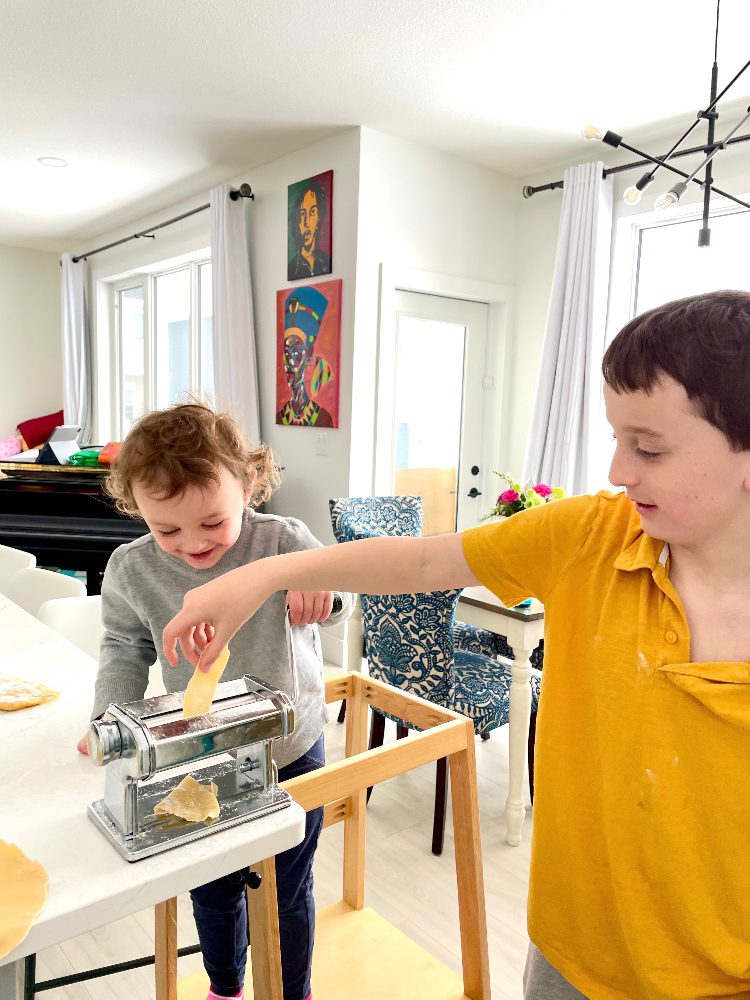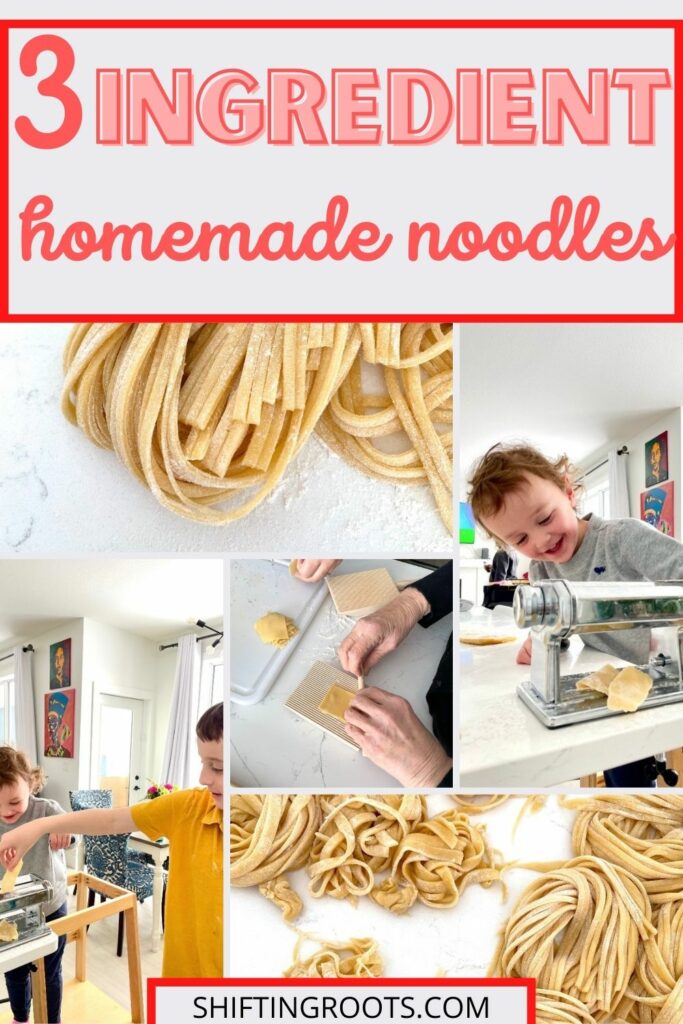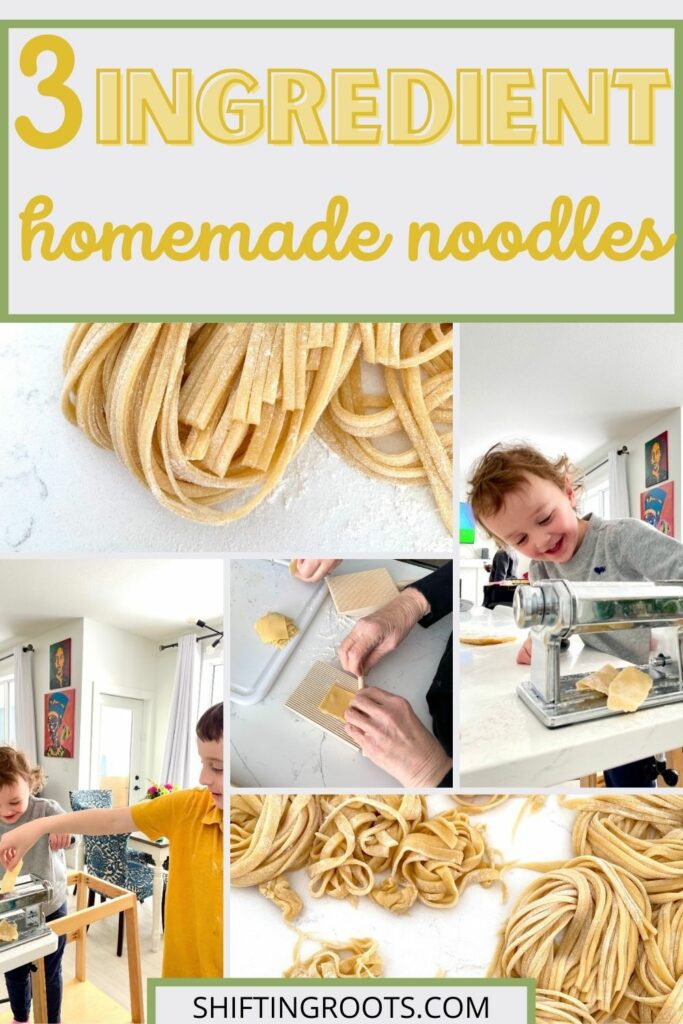It’s cold out. We can’t do a lot of gardening or outdoor activities, so it’s the perfect time to dust off those homesteading skills and prep some noodles for the coming year. If you live in a dry, prairie climate like I do in Saskatoon, Saskatchewan, winter is the ideal time to make noodles. The air is dry which means your noodles will dry faster without any extra effort on your part.
However, there are still a few things that are tricky when making homemade noodles.
In addition to the no-fail homemade noodle recipe I use, I will also give you some helpful tips for making egg noodles from scratch, so that they are as close to perfect every time. If you’re more of a visual learner, watch this super quick Instagram reel on how to make homemade noodles at home.
DISCLAIMER: If you don’t care about the tips and tricks and you just want to get cooking, scroll down to the recipe card. Sorry about being one of those food bloggers… #sorrynotsorry

Try this delicious roasted tomato sauce to go with your pasta.
HOW TO PROPERLY USE A MANUAL PASTA MAKER
Contrary to what the world might tell you, you do not need a bunch of fancy equipment to make homemade noodles. No, you don’t need the $200 pasta maker that attaches to your KitchenAid. A simple, hand-crank pasta maker is all you need. It is possible to make pasta without this machine, but it will take much longer. You will have to roll out the dough until it is extremely thin and cut it all by hand.
Pasta makers are pretty reliable. Just watch that you have enough flour on the dough, so it goes through the machine cleanly. If your dough gets stuck in the pasta maker, the machine could break from prying and digging it out. This is especially true when using the cutting blade. So, if you find yourself asking is there enough flour on the dough? the answer is no. (Ok, the answer might be yes, but if you are in doubt, add more flour.)
When you buy your pasta maker, you will notice a dial on the side with a bunch of different numbers. Those numbers correspond with the desired thickness. The higher the number, the thinner the noodle. If you decided the optimal thickness of your pasta is a 5, it doesn’t mean you should start there. Always begin rolling the dough at 0 and then increase the dial 1-2 levels at a time. Make sure to add flour as you go if the dough gets sticky. Otherwise, keep rolling.
If you’re looking for a dependable pasta maker, we use something similar to this model in our house.
I know it would be logical to put the recipe here. If I was a nice person, I would. But I have to make you work for that $0.10 ad income.
ARE EGG NOODLES THE SAME AS PASTA?
Yes and no. Egg noodles are basically the same as regular pasta, but they just require different flour. In my opinion, all-purpose flour is best for egg noodles and semolina flour is best for “pasta.”
EXPECTATIONS IF YOU’VE NEVER EATEN HOMEMADE EGG NOODLES
Homemade pasta is going to be chewier than regular pasta. It just is. If you’re expecting the noodles to taste exactly the same as storebought dried pasta, don’t. Because they won’t. However, once you taste fresh pasta for the first time, whatever previous sadness you had that it’s not this dried-out thing from a box will melt away.
The two keys to great tasting, fresh, homemade pasta are adding lots of salt to the water, even as much as three tablespoons (if it tastes like the ocean, you’ve added enough), and boiling the noodles for no longer than 2 minutes. This boil time will give you al dente pasta. If you’re someone who doesn’t typically like al dente pasta when it’s dry from the box, you might be pleasantly surprised when you try homemade pasta made this way.

Like this recipe? Check out these blog posts to start your home canning journey:
The Beginners Guide to Home Canning & Must-Have Equipment for Home Canning
DO I NEED TO DRY MY HOMEMADE NOODLES?
If you’re making noodles for storage and not immediate consumption, yes. When I’ve made homemade noodles in the past, we’ve always let them dry at least overnight before packing them up in bags and putting them in the freezer. Be warned, noodles in the freezer do break easily. If you really want them to retain their shape, you will have to be very careful with how you package them and where you store them. Finally, if broken noodles really bother you, then opt for using a thicker setting than you normally would, so the noodles aren’t quite as easy to break.
3-INGREDIENT EGG NOODLES ARE SURPRISINGLY KID-FRIENDLY
I have three kids and two of the kids helped me with the noodle making. My nine-year-old is typically not that interested in hands-on projects or helping a bunch in the kitchen, but he loved making noodles. It was a nice and easy project. He could easily crank the dough and pull out the noodles. I also gave him his own bit of dough (we called it “baby noodle”) to roll out and make his own noodle shapes. We had lots of fun.
My son is also a very picky eater, and he rated these noodles a 100/10.
No joke.
I was surprised at how much my two-year-old was able to participate in the noodle-making activity, as well. Making noodles really held her attention. We tried to lure her away with an episode of Peppa Pig, but she would not be moved. She was committed to making noodles. She was able to help me with the crank, and she was able to pull out the noodles with a little bit of supervision from big brother. Afterwards, a few of the misshapen or smaller noodles were a fantastic distraction to get her to play by herself while we were waiting for dinner.
Safe to say, this is an activity that you can involve your children in, and they will actually be happy doing it.

Thinking of adding your homemade noodles to a soup? How to Make Soup from Scratch
FINALLY, THE RECIPE…
The Golden Ratio
For those of you who are more confident in the kitchen, or if know you need to make a smaller or larger batch of noodles than what I’ve outlined in the recipe card, this is the golden ratio for homemade egg noodles: 2 flour, 2 eggs, 1 yolk, 2 tsp. (approximately) oil. If you like content like this, follow me on Instagram for homesteading, self-sufficiency skills, as well as lots of gardening and cut flower goodness.

3-Ingredient Homemade Noodles
An easy 3-ingredient recipe for homemade egg noodles.
Ingredients
- 6 cups flour
- 6 eggs
- 3 egg yolks
- 2 tbsp. oil
- a small amount of water, if needed (add 1 tsp. at a time)
Instructions
- Put flour in a medium-large bowl and make a well.
- Put eggs and egg yolks into well. Scramble lightly with a fork.
- Add oil.
- Mix with a dough hook, if you’re using a KitchenAid mixer. If not, start kneading. The dough is ready if it springs back easily when you press down with your fingers. If you aren't sure, keep kneading. It is almost impossible to over-knead pasta dough.
- Once the dough has been kneaded thoroughly, wrap in saran wrap or put in a clean bowl with saran wrap over top. Put in the fridge for a minimum of 1 hour (preferably overnight).
- When you’re ready to make the noodles, divide the dough into small sections. We divided ours into 8 and found it was a manageable amount of dough to handle at one time.
- Roll out each section of dough into a rectangular shape. Cover liberally with flour.
- Roll the section of dough through the pasta maker starting at 0 and slowly making your way up to your desired thinness. (Our family prefers setting 5.)
- Attach cutter to the pasta maker, and cut your desired shape.
- Boil for 2 minutes in heavily salted water.
- Eat and enjoy.
Notes
If you’re drying the noodles for storage. Let dry for a minimum of 24-hours to a maximum of 72-hours. You may need to adjust if you live in a more humid climate.



Join the conversation